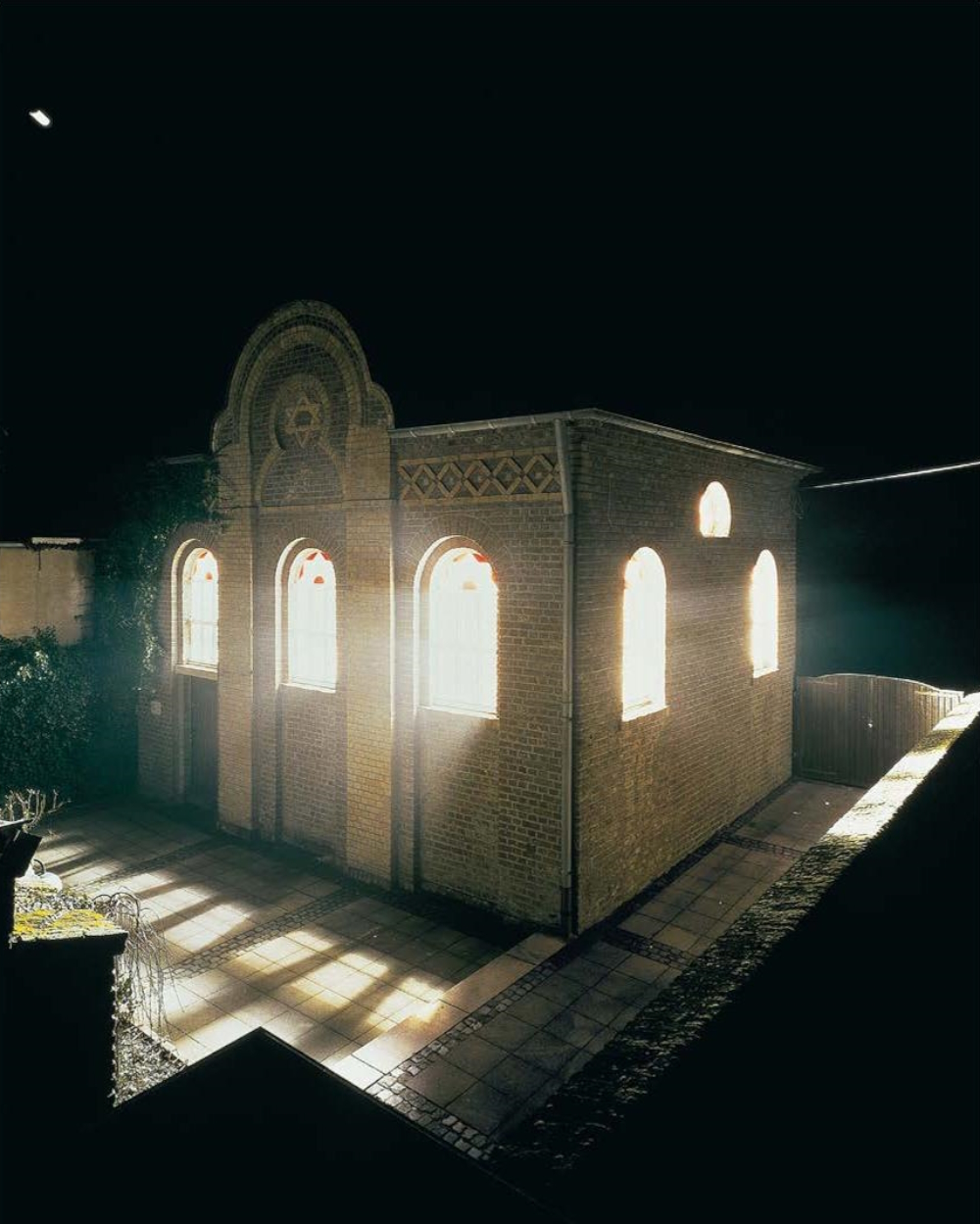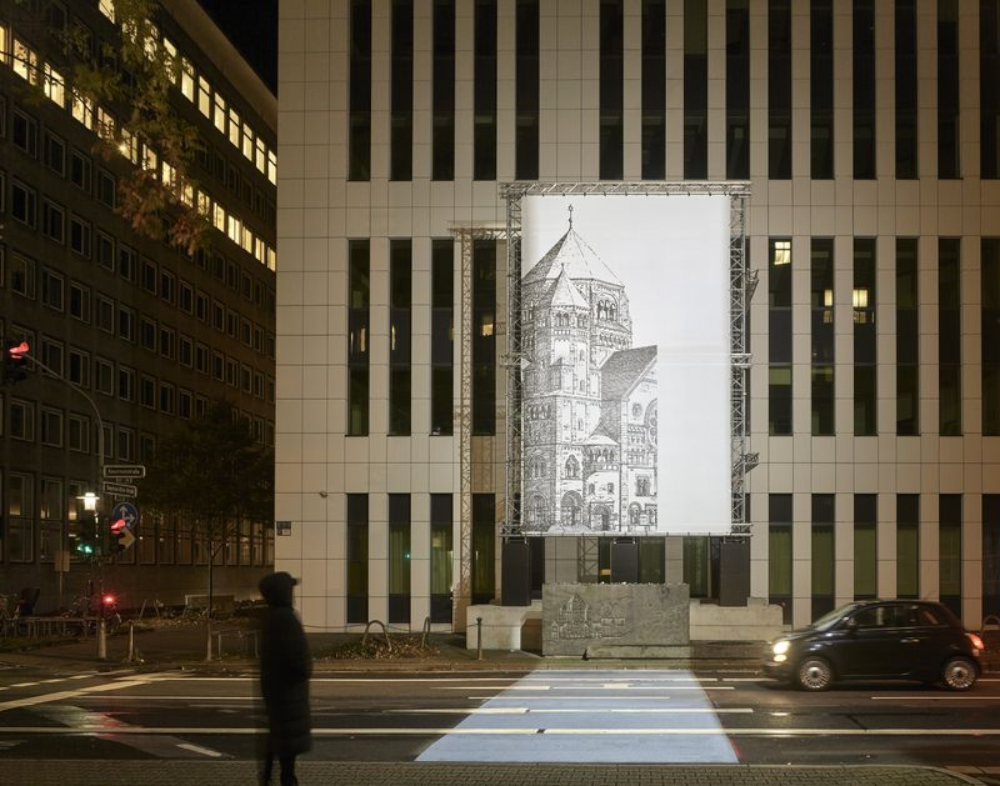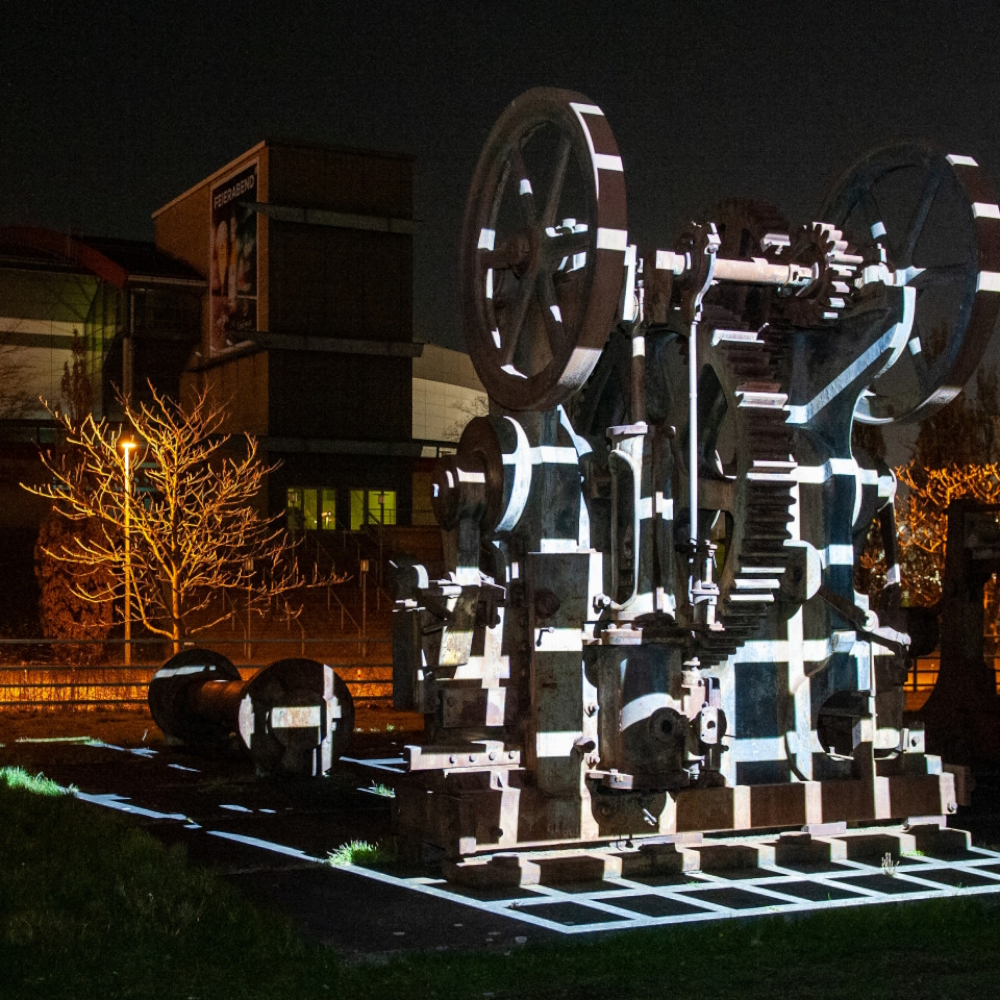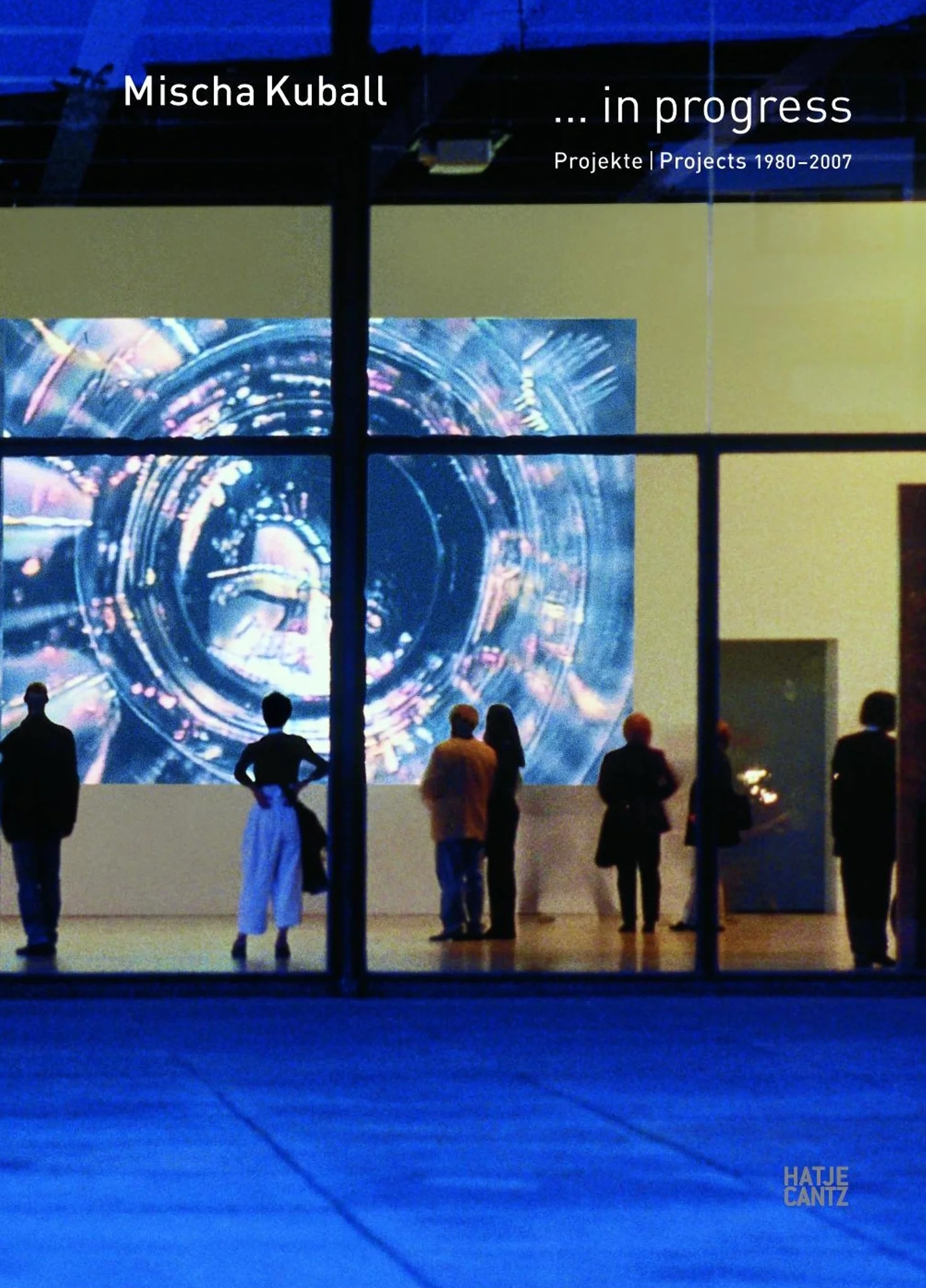Mischa Kuball
awarded conceptual artist
Germany
Glistening light from inside a Jewish synagogue in Germany, which was hermetically sealed for eight weeks, flooded the nights and the location became „refraction house“. This fascinating, unmissable, but also difficult to bear monument, is a represantative example of this creative artist’s work. He has been honoured with the light art prize "for his outstanding use of light as a medium of public (inter)action" (quote from the foundation's declaration). "In his installations, the man reveals the political and social dimensions of light as an artistic material." He is one of the few German artists who has been developing his own oeuvre for decades, independent of the fashions of the art market. Nevertheless this conceptualist celebrates his works worldwide in the public space of Jerusalem, Venice, Marfa/US, Toronto, Bern/Switzerland, Katowice/Poland, Christchurch/New Zealand, Rio de Janeiro, Tokushima/Japan or Montevideo/Uruguay. His international presence is even more impressive for someone who holds Germany's only professorship for "public art/art in public space" bearing in mind that he didn’t study art!
Mischa Kuball
awarded conceptual artist
Germany
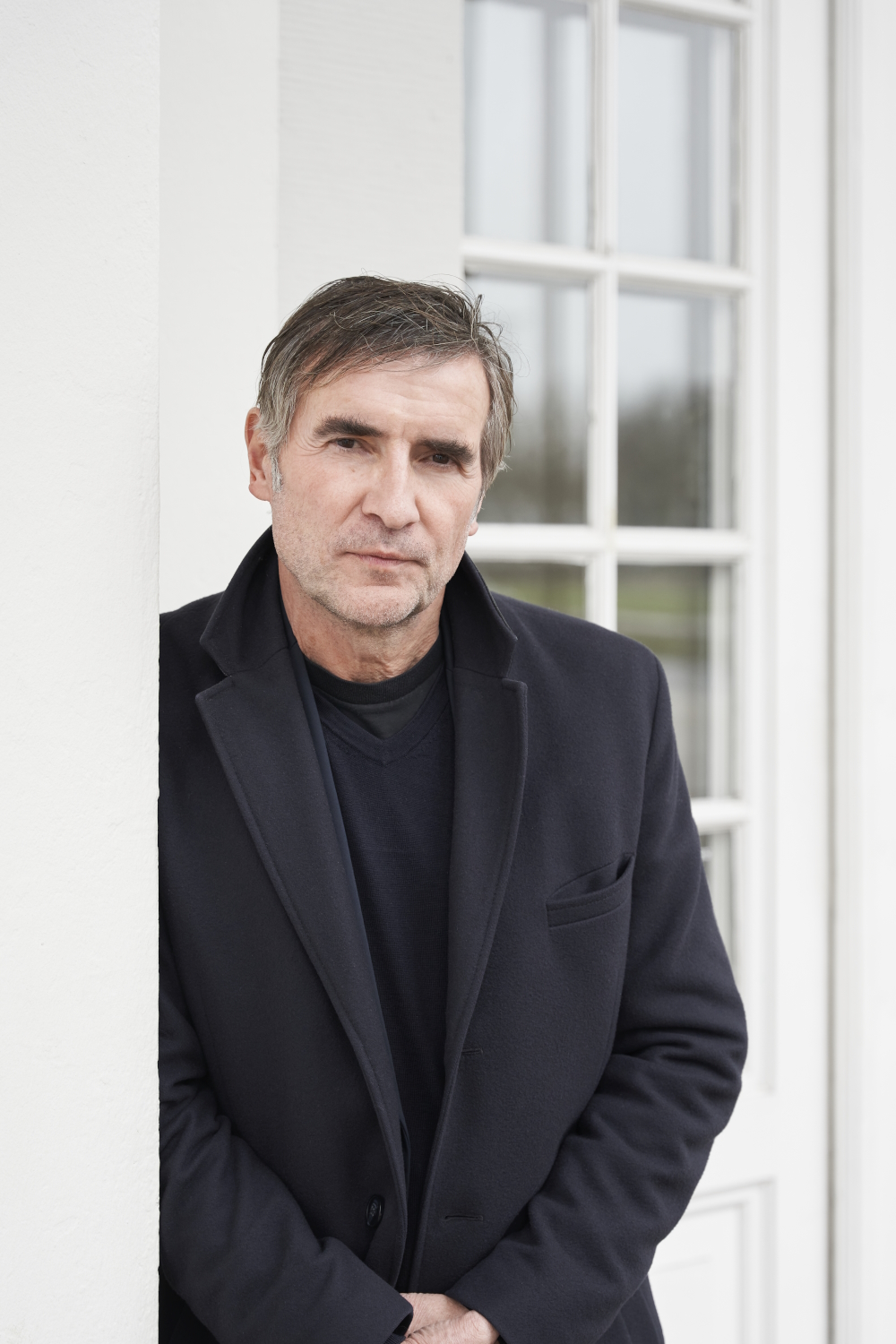
Mischa Kuball (* 20 September 1959 in Duesseldorf) studied philosophy, but became well-known as an artist. With such a solid background it’s no surprise that his output since 1980 has a lot to communicate.
The substance of a deeper meaning is important for him according to his interview with German business-newspaper handelsblatt.com/arts: „The use of light has experienced an inflation. The privilege of bringing light to the people, as in the philosophy of the Enlightenment, has long since been taken over by players who have the technical possibilities but no longer want to provide any impetus in terms of content. In the past, church towers, town halls and meeting places were illuminated. Today, everything can be illuminated, even your own detached house, and charged with a supposed 'meaning' that it ultimately doesn't have. That's why I have to ask myself very carefully where and when I use this medium in order to be able to set this enlightening impulse.“
The fan of Peter Gabriel’s song „Solsbury Hill“ and the electronic music of Hans-Joachim Roedelius as well as Daniel Ansorge quickly follows words with deeds. A represantive example is the „missing link_“ installation in his hometown’s center. At the site only a dark, unobtrusive stone plaque reminds of the Great Synagogue that was a spiritual home for 5.500 people up until the Nazis burnt down the sacral architecture in early November 1938. Mischa Kuball secured „that the section of road in front of the memorial stone is brightly lit. A spotlight shines across the street onto a large banner hanging in front of the façade of the new building. It shows a large image of the old synagogue. "It's a real physical moment of pause that happens here," the maker is quoted in monopol-magazin.de. „The project brings the almost forgotten synagogue back to mind."
For a good reason the enthusiastic marathon runner can claim for himself being a „catalyser for processes in public space“ (deutschlandfunk.de). Despite the fact that German history as well as the Holocaust have always been central topics for him and he considers works as such a sign of peace, they‘re just one part of his artistic creation’s broad spectrum. That is presented in Kuball‘s books „...in progress. Projects 1980-2007“ and „public prepositions. 2009-2015“. In the first one Yukito Shikata, curator and critic of 20th-century art and media art as well as Visiting professor at Tama Art University and Tokyo Zokei University writes: "The phenomenological effects of lights - radiating, making visible, drawing attention to something - are used in such a way that the viewer's consciousness activated by them reaches beyond the symbolic connotations of the light itself."
The famous non-profit German cultural Goethe Institute notes on its website that the member of the Academy of Sciences and Arts NRW in Duesseldorf „explores architectural spaces and their social and political discourses by using the medium of light - in installations and photographs. He reflects on the various facets, from cultural social structures to architectural interventions that emphasise or recode the landmark character and architectural-historical context. Politically motivated and participatory projects interweave public and private space. They enable communication between the participants, the artist, the work and the urban space.“
During his laudation at the ceremony of the light art prize in 2016 Michael Schwarz (1940-2021), a former doctor of art history and professor of modern art history, aptly described Mischa Kuball as a "director of light" and a "gifted communicator and mediator of his work ideas", reported the daily newspaper Cellesche Zeitung. „Schwarz explained with almost rapturous enthusiasm the certain something about the artist that distinguishes his work from other works of light: it is the reference to people, who are "not only allowed to observe, but also to act" and are involved. And using specific examples, he explained how Kuball gears his projects towards the uniqueness of the respective location, building or square and relies on communication, solidarity and identification of those involved on site during realisation.“
Mischa Kuball and his wife Michèle are based in Duesseldorf, Germany.
Interview December 2023
Education of a different kind: the (socio)political dimension of light
INTUITION/IMAGINATION
?: How does intuition present itself to you – in form of a suspicious impression, a spontaneous visualisation or whatever - maybe in dreams?
Most of the time it appears shortly after awakening - or just before deep sleep phase - sometimes in Transit btw travels - or during may morning running routine…
?: Will any ideas be written down immediately and archived?
Yes, I record what comes to my mind - in earlier days it was archived in a sketch book, now it's random as it could happen anytime anywhere - or just on a small piece of paper.
?: How do you come up with good or extraordinary ideas?
By sitting down and thinking about it - but also while I am reading a book, or an essay…
?: Do you feel that new creative ideas come as a whole or do you get like a little seed of inspiration that evolves into something else and has to be realized by endless trials and errors in form of constant developments until the final result?
It could start with a glimpse, a flash light impulse …
?: What if there is a deadline, but no intuition? Does the first fuel the latter maybe?
Not at all - all kinds of pressure do not support the flow!
INSPIRATION
?: What inspires you and how do you stimulate this special form of imaginativeness?
… running - minimum 15K daily - is offering a moment of infinite reception of time - this is a real stimulation to me…
?: How do you filter between ideas that are worthwhile pursuing and bad ones that you just let go of?
Bad ideas?
This category does not exist to me -
but small ideas could sum up to a bigger one, in any case it will lead to something - this is the promise, at least; if not - I would not talk about it ;-)
?: Does an idea need to appeal to you primarily or is its commercial potential an essential factor?
Sorry, but commercial ideas never reach me - mostly I need a budget to realize the idea - rather to make any profit out of it!
?: Do you revisit old ideas or check what colleagues or competitors are up to at times?
Well, it's always a pleasure to discuss ideas - there is no out of date feeling about it - it's more about - that the idea has its value - but the context has changed - so it should not be an appropriate project anymore…
CREATIVITY
?: What time or environment best suits your creative work process — for example, a time and place of tranquility or of pressure? Which path do you take from theory or idea to creation?
Absolutely early morning time is best for me - during the day other duties may catch my attention, or as said earlier - it works in the middle of the night.
?: What’s better in the realization process — for example, speed and forcing creativity by grasping the magic of the moment or a slow, ripening process for implementation and elaboration?
I think it s all about the mix - could start with a magical moment, running into a pragmatic phase, then - especially by technical driven installations - the light takes over and the magic may return !
?: How important are self-doubt and criticism by others during such a process?
If you are not critical toward yourself you can’t judge other people - as I need to in my relation to my students - and - I need to be confident - after going thru massive self criticism - to move on - too much on stake here…
?: Is it better to be creative on your own, to trust only your own instincts, or to work in a team?
First impulses are most delivered to me as a solo individual - to move on it involves people, team players - such as my studio team - it also allows multi authorship.
?: In case of a creative block or, worse, a real failure, how do you get out of such a hole?
Hole? Black holes?
If so - what I cannot report on - black holes are filled with energy … so I recommend to think about where are you now?!
?: Should a creative person always stay true to him- or herself, including taking risks and going against the flow, or must the person, for reasons of commercial survival, make concessions to the demands of the market, the wishes of clients and the audience’s expectations?
Is there an option? honestly? truth is value on its own - you don’t mess around with…
?: How are innovation and improvement possible if you’ve established a distinctive style? Is it good to be ahead of your time, even if you hazard not being understood?
I have a passion and dedication to my work, that may include different styles - but never been addicted to one decision which always has to match with a design masterplan….and in the process of making I don’t take a possible audience into account.
?: When does the time come to end the creative process, to be content and set the final result free? Or is it always a work-in-progress, with an endless possibility of improvement?
Depends, some projects do require a certain maintenance after reception/opening - in this sense one could speak of an open process - also in many projects we are asked to keep track and record the feedback, incl. media coverage / clipping, or visitor evaluation.
?: How does artificial intelligence change human creativity? And do you? Would will you use it at all?
Not at this point of my practice - I know it's out there - but I am not using it currently by purpose - But I will in the near future.
SUCCESS
?: “Success is the ability to go from one failure to another with no loss of enthusiasm.“ Do you agree with Winston Churchill’s quote?
Sounds like a plan - but also true is you need to be equipped mentally for this State of Mind - Churchill was prepared, I bet.
?: Should or can you resist the temptation to recycle a ‘formula’ you're successful with?
Very little receptions available at this end - but also true - sometimes the next version of an idea is the better version of the first one - but it also comes with no guaranteed approval.
?: Is it desirable to create an ultimate or timeless work? Doesn’t “top of the ladder” bring up the question, “What’s next?” — that is, isn’t such a personal peak “the end”?
I can’t answer with experience - I never see myself on any career ladder - most likely in process - and with other people … I think if you allow yourself viewing yourself in a ‚position‘ you empower other people to compare - this would be difficult for me to handle and coop with.
MY FAVORITE WORK:
refraction house, Synagoge Stommeln, Pulheim, Germany (1994)
The synagogue in Stommeln the Lower Rhine can barely be seen from the main street and is set back in a courtyard. For a period of eight weeks, the building was closed and lit from the inside with intense light, so that the building illuminated the surrounding area like a light sculpture, becoming a symbol that could be seen from afar.
The synagogue in Stommeln is one of the few in Germany that was not destroyed during the pogroms of 1938, located in the backyard but hardly visible. To create a new perception for the place among the population, the work Refraction House was realized. During a period of eight weeks, the building was closed and flooded with intense light inside, so that the architecture shone like a light sculpture in the surroundings and made a visible sign from afar. The synagogue, nested and hidden as it is, became a point of attraction for curiosity; when approached, however, the glaring spotlights repel, virtually forbid entry, and draw all attention back to the viewer himself and the surroundings, of which the cultic space is the center. Thus there is a sharp contrast between the concentration of the monument outshining itself on the one hand, and the diffusion of a light on the other, which projects no images or geometric forms, but only itself, as it were.
